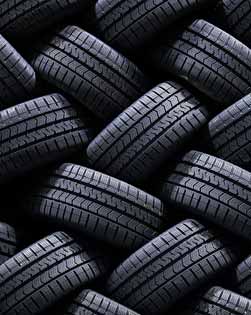- Abrasion resistance: The resistance to abrasive wear.
- Acid Resistant: Resistance to the action of acids.
- Aging: Exposing materials to an environment for a period of time.
- Butyl: Synthetic rubber exhibiting very low permeability to gases. Copolymer of isobutylene and isoprene.
- Durometer: An instrument for calculating the hardness of vulcanized rubber.
- Elasticity: The property to return to its original shape after deformation.
- Elastomer: A term used to describe elastic polymers having rubber-like behavior.
- Elongation: Extension which is produced by a tensile stress.
- Expanded Rubber: Cellular rubber made from a solid rubber compound and having closed cells.
- Extrusion: The process under which pressure is forced through the opening of a die in order to obtain a desired cross sectional shape.
- Hardness (durometer): It is a property of rubber stocks which is difficult to define except by considering the methods used to determine it.
- Heat resistance: The ability of rubber to retain its properties even under the destructive influence of heat.
- Hypalon: A synthetic rubber that is completely resistant to ozone attack under the most extreme conditions and also possesses excellent color stability including the action of acids, bases, and many other chemicals.
- Low temperature flexibility: This is the temperature at which the rubber becomes too stiff to function in its usual manner.
- Natural Rubber: Rubber obtained from latex of the rubber tree.
- Neoprene: A polymer of chloroprene and is prepared from coal, salt and limestone. Neoprene is a synthetic rubber used in weather-resistant products, adhesives, shoe soles, sportswear, paints, and rocket fuels.
- Nitrile rubber: A copolymer of butadiene and acrylinitrile.
- Oxidation resistance: The ability of rubber to withstand the reaction of atmospheric oxygen.
- Oil Resistant: Ability of a vulcanized rubber to withstand the swelling and deteriorating effects of various type of oils.
- Plasticisers: Liquids which are used to soften rubber.
- Polymer: It is a general term used to describe all rubbers and plastics.
- Resilience: Capability of a material to return to its original size and shape even after after deformation.
- Rubber: A material that displays elastic properties that allow recovery from large deformations quickly and forcibly.
- SBR: Styrene Butadiene Rubber. Copolymer of Butadiene. An all-purpose type synthetic similar to natural rubber.
- Silicone rubber: A type of synthetic rubber containing silicone.
- Synthetic rubber: Man-made rubber
- Temperature Range: It is the range in which it shows the lowest temperature at which rubber remains flexible and the highest temperature at which it will function.
- Tensile strength: The tensile strength of a rubber compound is the resistance of the rubber to rupture under tension.
- Vulcanization: An process in which a rubber compound through a change in its chemical structure becomes less plastic and more resistant to swelling by organic liquids and elastic properties are conferred, improved, or extended over a wider range of temperature.


Product Catalog
Industrial Applications
Industrial Rubber Products
Types of Synthetic Rubber
General Information
- Anti Vibration Mountings
- Automobile Rubber Products
- Calendered Rubber Products
- Extruded Rubber Products
- Medical Rubber Products
- Metal Bonded Components
- Rubber Adhesives & Sealants
- Rubber Ball
- Rubber Bands
- Rubber Beading
- Rubber Bearing
- Rubber Belt
- Rubber Buckets
- Rubber Bullets
- Rubber Cable
- Rubber Coating
- Rubber Duct
- Rubber Expansion Joints
- Rubber Flooring/Matting
- Rubber Footwear
- Rubber Gloves
- Rubber Injection Parts
- Rubber Lining
- Rubber Magnets
- Rubber Molded Products
- Rubber Pads
- Rubber Rollers
- Rubber Stopper
- Rubber Suit
- Rubber Track
- Rubber Valve
- Rubber Balloon
- Rubber Stamps
- Rubber Fenders
- Acrylic Rubber (ACM)
- Butadiene Rubber (BR)
- Butyl Rubber (IIR)
- Chlorosulfonated Polyethylene(CSM)/ Hypalon
- Ethylene Propylene Diene Monomer
- Fluoroelastomers (FKM)/Viton
- Isoprene Rubber (IR)
- Nitrile Rubber (NBR)
- Perfluoroelastomer (FFKM)
- Polychloroprene (CR)/Neoprene
- Polysulfide Rubber (PSR)
- Silicone Rubber (SiR)
- Styrene Butadiene Rubber
Featured Articles
How to Make a Custom Rubber Stamp?
Whenever designing a custom stamp for your company, never compromise on its quality because in the end it is the most...
Read MoreLatex and Silicone Rubber Tubing - A Comparison!
Many industries use rubber tubing for various purposes. In fact, various types of rubber tubing are used for different applications...
Read MoreSilicone vs Acrylic Adhesive- A Comparison
Silicon and acrylic adhesives are those rubber adhesives that are widely used in Polyimide tapes. In fact, the polyimide...
Read More
Copyright 2022 Industrial Rubber Goods All rights reserved.

